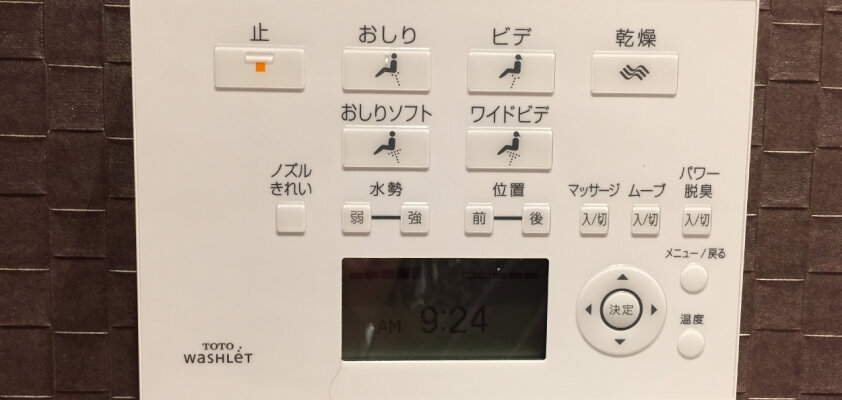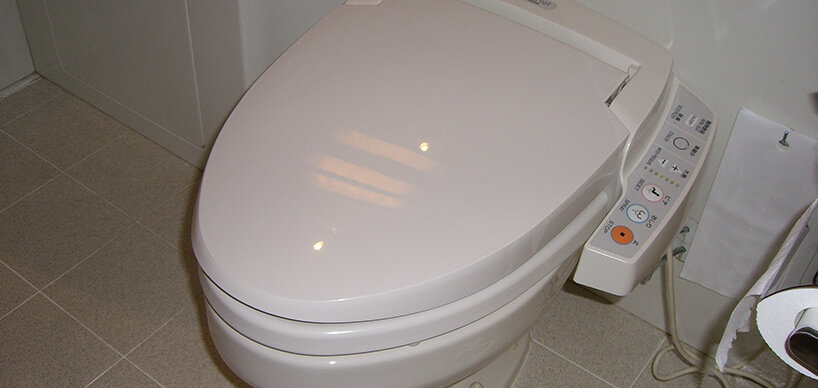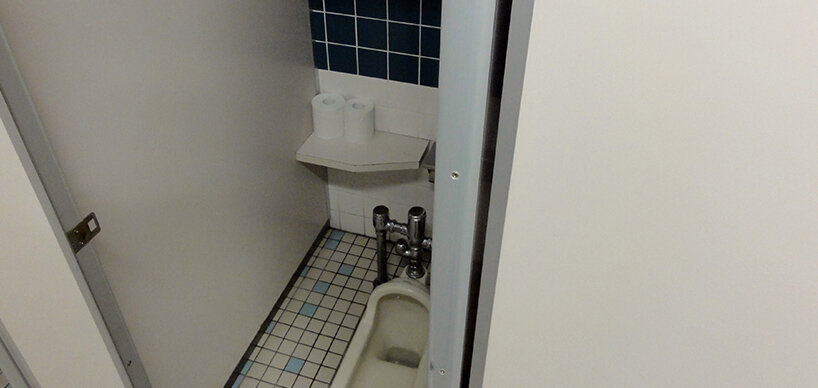The Curiosity of the Japanese Toilet

Taboo topic? Not in Japan. While our toilets simply serve their purpose, in Japan, it becomes a special experience – or a challenge.
Japan's high-tech toilet: blessing and curse
Almost everyone who has been to Japan has encountered the experience of high-tech toilets with many buttons. Each person has their own story to tell about the first encounter with toilets in Japan. Almost as complex, confusing, and exciting as the cockpit of a spaceship: these modern bowls can bring joy but also frustration. Because if you press the wrong button the first time, you might end up with an involuntary shower. The modern bidet toilet in Japan is also called Washlet, a combination of "Wash" and "Toilet," or simply: "Let's wash." This indicates that, thanks to their shower and bidet functions, they can also clean with water. Interestingly, the most common Japanese word トイレ (toire) for toilet comes from English and is written in katakana, indicating loanwords from foreign languages. Other terms literally mean "wash hands" and "powder room" to keep it discreet. With the modern bidet Japanese style, there are various modes that can be selected with the numerous buttons on the bowl. Although they contain symbols instead of characters unfamiliar to us, only experimentation helps. This is the only way to find out what Japanese Washlets can do, even though it can backfire. But once you get the hang of it, you'll appreciate the many features of such a toilet in Japan. No one can resist a pleasantly heated seat in winter, and nothing works without the discreet hum.

Picture Credits: Author: Achim Hepp | Flickr | License
Shower toilet with numerous functions
The sound function, reminiscent of flowing water, was incorporated because embarrassed toilet users – especially Japanese women – found the sounds too embarrassing, and they used to let the flush run for a long time. To save water, the company Toto developed the "singing toilet." After all, frugality is also part of Japanese culture and is anchored in the concept of Mottainai (literally: "do not waste"). In Japanese, the acoustic part of the high-tech toilets is called Otohime, which translates to "Sound Princess." Originally, this was the name of a Japanese goddess and dragon princess from mythology, who lived in a palace at the bottom of the sea. Toto is the leading manufacturer of sanitary facilities in Japan and introduced the high-tech toilet to Japan. The first usable Washlet was developed in Japan in 1980 and trademarked. At that time, it was modestly equipped with a washing function for the rear area, dryer, and seat heating. When advertising for it first appeared on Japanese television two years later, many viewers were shocked – but Japan quickly adapts to new technological developments. Soon, the novel toilet from Japanese high-tech culture became indispensable. Later, numerous special functions were added. A modern Washlet from Japan can have the following features today:
- Bidet and shower for front and rear
- Built-in air dryer
- Heated seat
- Otohime – Sound Princess
- Spraying deodorant and scent
- Temperature and strength of the water jet can be adjusted, and there is even a massage function
- The toilet lid opens automatically when entering the bathroom
- Special self-cleaning technology with electrolyzed water to use fewer chemicals
- Water and space-saving flushing, partly automatic
- Sleek and aesthetic design
Features such as the perfect angle for the water jet, optimal water pressure, and comfortable seat temperature have been discovered through years of research. In the future, they also want to incorporate medical features such as measuring blood sugar, blood pressure, and body fat percentage. They are also developing a personal greeting when entering the toilet and voice recognition control. We are indeed not far from the spaceship.
Toilet meets culture
Hard to believe that Japan was not always so comfortable. Japanese toilets also have another side: the traditional Asian "squat toilet." Known as the "Squatty potty" in English, the name already suggests what you should do there: squat. This does not seem comfortable and can be a shock or a challenge for some unsuspecting tourists in an otherwise advanced country. However, this type of toilet has been proven to be healthy and hygienic, as you don't have to touch anything. The simple squat toilet is also found in many other parts of the world, especially in Southeast Asia, Africa, and the Middle East, as well as Eastern Europe. In Muslim and Hindu-influenced countries, people also prefer water over toilet paper, similar to the bidet toilet. Speaking of toilet paper: if you try to use it in Japan as in the West, you may encounter difficulties. While it is folded in the West, it is simply crumpled in Japan. Accordingly, the paper is designed differently and is not marked with perforations, making folding more challenging. Crumpling is also common in the USA. Unlike there, the design of toilet doors is different in Japan: you mostly find toilet doors that go down to the floor. For many Japanese in America, the generous gaps between the floor and the door, where you can see the feet, can be a cultural shock.
Japanese gods also for WCs
Interestingly, in Japan, you often find the traditional and modern versions of toilets together, especially in public toilets at major train stations and department stores. The squat toilets are then marked with a specific symbol on the door, so you don't accidentally enter one. If you want to benefit from the latest technology, you may have to endure longer waiting times. However, public toilets in Japan are available everywhere, even in small supermarkets, known as "Konbinis" (short for "Convenience Store"). These toilets are also free—a luxury that is hard to find in other countries. Regardless of the location, you will hardly find dirty toilets in Japan because cleanliness and respect for others are sacred there, as in other areas. Traditionally, recycling the contents of the toilet as fertilizer was considered sacred. This practice was a way of paying homage to the gods of the restroom, who were believed to protect people from falling in and drowning. This was actually a danger in the past since toilets were often dark. In some regions where the gods were considered beautiful, the toilets were kept in good condition and decorated. This was believed to ensure that newborns would be good-looking according to mythology and protect the toilets from evil spirits.

Picture Credits: Author: Ari Helminen | Flickr | License
Using toilets correctly in Japan: Tips
Is the topic too indecent? It's also a matter of culture. Japanese people often seem paradoxical to us: criticizing others or eating on the train is a no-go, yet they don't hold back when it comes to toilet topics. Even at the dining table, everyone probably has a "toilet story" to tell: about haunted toilets in schools or villains hiding in bowls. In contrast, toilets in Japan come with strict rules and etiquette. One difference from the West is that the toilet in Japanese households is usually positioned separately. This is because the toilet, similar to everything outside the house, is considered an impure place and traditionally separated from the rest of the apartment. This also extends to shoes: not only in homes but also in public facilities such as gyms, you'll find slippers at the entrance. You should put them on when entering the toilet – and don't forget to take them off when leaving! Inside Japanese homes, people don't wear any shoes, especially not those that have been in the restroom. There's a lot of potential for embarrassing situations here. If you encounter a Japanese squat toilet for the first time, there's no need to worry: they are cleverly designed to remain comfortable and clean once you get the hang of it. While squat toilets in the rest of the world usually only consist of a hole in the floor, in Japan, you need to stand correctly towards the elevated part facing away from the entrance.
Other issues arise with Japanese washlets. If you accidentally trigger the shower function or the "Sound Princess" doesn't stop automatically, you can end all modes by pressing the red button with the 止 symbol (meaning "Stop"). Flushing in such a toilet is also not so simple the first time: you won't find it among the other buttons on the "cockpit." Often, there is a lever on the side of the flush tank, easily overlooked. This lever displays two characters: 大 for "large" and 小 for "small." Depending on how much you want to flush, press the lever to the left or right. Sometimes, especially with traditional squat toilets, there's only one lever on the inlet pipe that you need to push down. The highly modern version has a button or even a sensor where you just need to hold your hand. Or the toilet flushes automatically when you stand up. Hygienic and quick at the same time.
Japanese Washlets soon here too?
In the 90s, the Japanese bidet toilet left Japan for the first time and arrived in the USA. Today, it is available worldwide. The question arises: Why hasn't the Japanese version of the toilet gained popularity with us? Most of the time, the costs for the purchase and operation of a washlet are simply too high, and trust in the technology is still too low. However, many people already bring their Japanese comfort toilet with a stylish design into their homes privately. Apart from Toto, there are, of course, other companies that offer sometimes more affordable features or a toilet seat attachment for the home toilet. Would you also bring such a piece of Japanese luxury into your home – or is that simply too much?
Perhaps you're also interested in the article about the Japanese futon:











-from-the-yakiyaki-grill-pan.jpg)




